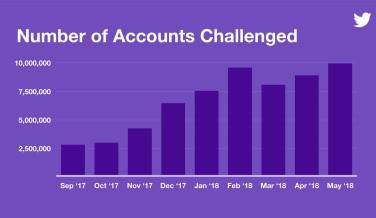Twitter announces new measures to fight spam and malicious automation
Every day, people go to Twitter to see what’s happening in India and around the world. One of the most important parts of Twitter’s focus on improving the health of conversations on the platform is ensuring people have access to credible, relevant, and high-quality information on Twitter. To help move towards this goal, Twitter introduced new measures to fight abuse and trolls, new policies on hateful conduct and violent extremism, and is bringing in new technology and staff to fight spam and abuse.
New Processes for Fighting Malicious Automation and Spam
Twitter fights spam and malicious automation strategically and at scale. The platform’s focus is increasingly on proactively identifying problematic accounts and behavior rather than waiting until Twitter receives a report. Twitter focuses on developing machine learning tools that identify and take action on networks of spammy or automated accounts automatically. This lets the platform tackle attempts to manipulate conversations on Twitter at scale, across languages and time zones, without relying on reactive reports.
Twitter has seen positive impact in investments in this space:
â— In May 2018, Twitter’s systems identified and challenged more than 9.9 million potentially spammy or automated accounts per week. That’s up from 6.4 million in December 2017, and 3.2 million in September.
â— Due to technology and process improvements during the past year, Twitter is now removing 214% more accounts for violating the platform’s spam policies on a year-on-year basis.
â— At the same time, the average number of spam reports Twitter received through its reporting flow continued to drop — from an average of approximately 25,000 per day in March, to approximately 17,000 per day in May. Twitter has also seen a 10% drop in spam reports from search as a result of its recent changes. These decreases in reports received means people are encountering less spam in their timeline, search, and across the Twitter product.
â— Twitter is also moving rapidly to curb spam and abuse originating via Twitter’s APIs. In Q1 2018, the platform suspended more than 142,000 applications in violation of its rules — collectively responsible for more than 130 million low-quality, spammy tweets. Twitter has maintained this pace of proactive action, removing an average of more than 49,000 malicious applications per month in April and May. Twitter is increasingly using automated and proactive detection methods to find misuses of the platform before they impact anyone’s experience. More than half of the applications Twitter suspended in Q1 were suspended within one week of registration, many within hours.
These numbers show that Twitter’s tools are working: Twitter is preventing or catching more of this activity itself before the users ever see it on Twitter.
Platform manipulation and spam are challenges the platform continues to face and which continue to evolve, and Twitter is striving to be more transparent with users about its work.
Today, Twitter is sharing four new steps it is taking to address these issues:
1) Reducing the visibility of suspicious accounts in Tweet and account metrics
2) Improving Twitter signup process
3) Auditing existing accounts for signs of automated signup
4) Expansion of its malicious behavior detection systems
What Users Can Do
There are important steps users can take to protect their security on Twitter:
â— Enable two-factor authentication. Instead of only entering a password to log in, they’ll also enter a code which is sent to their mobile phone. This verification helps make sure that only a user themselves can access their account.
â— Regularly review any third-party applications. Users can review and revoke access for applications by visiting the Apps tab in their account settings on twitter.com.
â— Don’t re-use a password across multiple platforms or websites. Have a unique password for each of the accounts.
â— Users can also use a FIDO Universal 2nd Factor (U2F) security key for login verification when signing into Twitter.
Starting today, you can use a security key for login verification when you sign in to https://t.co/I6k1ntZlAv.https://t.co/Cu3PUyBsxz
— Twitter Safety (@TwitterSafety) June 26, 2018
Additionally, if someone believes they may have been incorrectly actioned by one of Twitter’s automated spam detection systems, they can use Twitter’s appeals process to request review of their case.
Next Steps
Going forward, Twitter is continuing to invest across the board in its approach to these issues, including leveraging machine learning technology and partnerships with third parties. Twitter will soon announce the results of its Request for Proposals for public health metrics research. These issues are felt around the world, from elections to emergency events and high-profile public conversations. As Twitter has stated in recent announcements, the public health of the conversation on Twitter is a critical metric by which the platform will measure its success in these areas.





















Share
Facebook
YouTube
Tweet
Twitter
LinkedIn